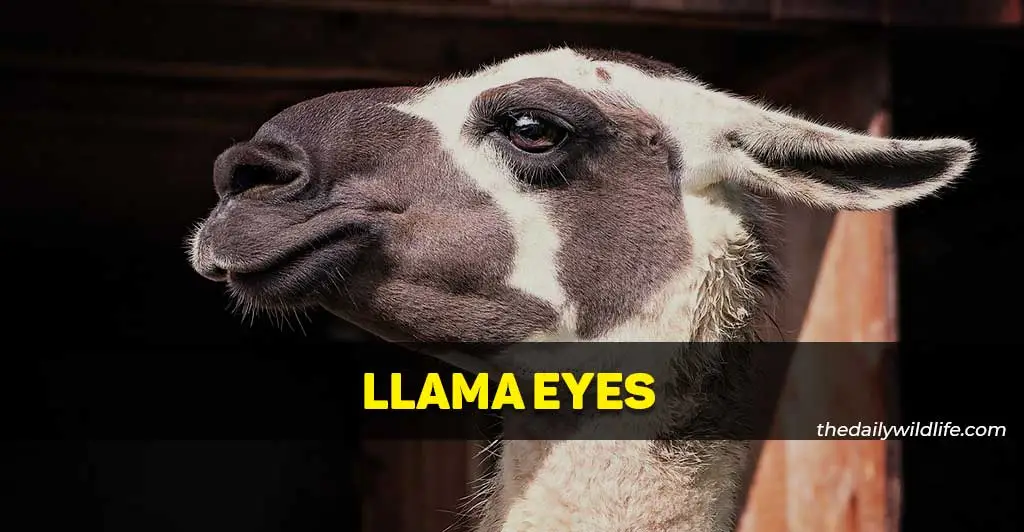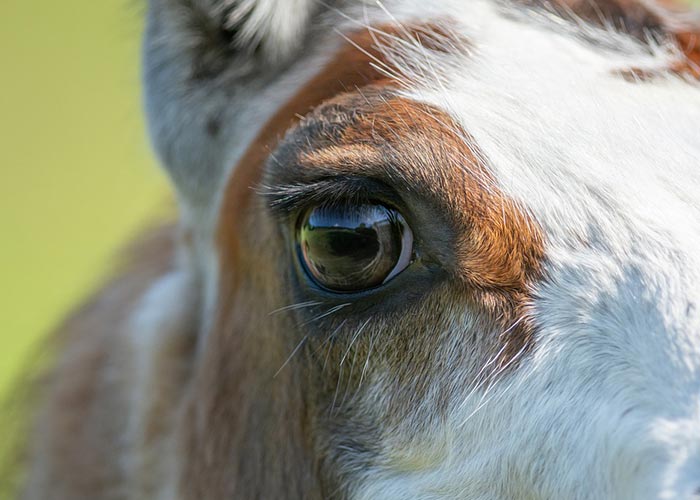Just like all other mammals, llamas too have two eyes on their heads. The head is small which makes their eyes more prominent. Llama’s eyes are large, expressive, and because of such size, prone to injuries.
A 19th-century Peruvian physician, Hipólito Unánue, praised the elegance of the llamas by saying that their eyes are “so beautiful and gleaming that any woman would be proud to own them“.
One of the most attractive features of a llama is its large and expressive eyes and long eyelashes. It’s no wonder people quickly fall in love with their soft gaze and friendly eyes.
So what makes the eyes of a llama so special?

Table of Contents
Quick Llama Eye Anatomy
The anatomy of a llama eye is similar to other mammals; it consists of:
- Three eyelids – prevent eye damage from particles and insects
- Lacrimal gland – produces tears
- Ocular muscle – moves the eyes
- Cornea – the protective outer layer of the eye
- Iris – regulates the amount of light that gets into the eye
- Corpus nigrum – improves vision in bright light
- Sclera – the white part of the eye
- Chorioid – brings oxygen and nutrients to the eye
- Retina – helps perceive light, color, and fine details
- Optic disc – a place where the optic nerve connects to the retina
- Lens – transmits light
- Cone – responsible for color vision
- Rod – responsible for vision at low light levels
Llamas have rods and cones in their eyes, this might suggest that they have color vision and are not color-blind.
A study of animal pupils found out that grazing animals will almost always have horizontally elongated pupils. This is the case with llamas too.
Horizontal pupils increase the amount of light the animal can receive in front of and behind while reducing the amount of light from above and below. This allows a llama to have a panoramic vision along the ground to help detect potential predators.
Do Llamas Have Good Eyesight?
Llamas have excellent eyesight and keen vision. Their large eyes are set at the sides of the skull; this provides excellent peripheral vision with a broad field of view to the animal.
Because of such vision, llamas rely on noticing movements in the distance to detect a stalking predator since they lack depth perception.
Many predators, however, have narrow eyes. This limits their field of vision to just what’s in front of them, but they get depth perception to pick out prey among the terrain and attack it.
Llamas have long necks, they hear well, and have good eyesight. They are also territorial animals that bond very quickly with goats, sheep, horses, and other animals on the farm.
That’s why farm owners take llamas as guard animals for their livestock. Llamas can spot out incoming danger, scream to warn the others, and then charge at the enemy to scare it away.
Llamas have a unique feature of their eyes, a so-called natural “sunglasses”.
These “sunglasses” are called iridic granules or corpora nigra. They look like frills and serve to protect the llama’s eyes from excessive sunlight.

Of course, llamas sleep with their eyes closed.
Llama Vs Alpaca Vision
Vision in llamas seems to be different from that of alpacas.
A study from 2000 discovered that alpacas have a better vision than llamas.
Alpacas are close to emmetropic – this means that they have naturally clear and nearly perfect vision.
Llamas are mildly myopic (nearsighted) and can’t clearly see objects that are far away. They also have astigmatism – this means they have blurry vision at all distances.
Female llamas have a worse vision than male llamas. The reason for that is unknown but scientists think it might come to differences in eye sizes.
Both llama and alpacas are dichromatic. This means that they only see shades of blue, yellow, and gray.
What Color Are Llama Eyes?
Llamas can have different eye colors. Their eyes can be dark, brown, clear blue, gray. Some llamas might have heterochromia (blue and black color in the same iris). A myth that blue-eyed llamas are blind is incorrect and has been proven wrong.
The color of the eyes is connected to the wool color. Llamas with a light color of their coat have combinations of gray, blue, and brown eye colors.
Llamas with dark coat colors generally have brown eye color.
The color of the eyes can make or break a llama’s position in llama shows. Blue eyes are very rare in llamas, but they are also considered a fault – a llama with blue eyes gets disqualified.
This is because most llamas of the blue-eyes white-coat phenotype are deaf.
In fact, a study 2020 study submitted in Acta Veterinaria Scandinavica journal discovered that out of 420 animals, every second llama with blue eyes (53.3%) was deaf.

Llama With Hair In Its Eyes
Llamas can be divided into two breeds: Kara and Chaku. The Kara llama (the most common type) is used as a pack animal, while Chaku is famous for its wool. Chaku can be distinguished from Kara by the thicker and coarse wool and the hair over its eyes.
Llamas as well as male alpacas can grow a tuft on their head that covers the eyes and the face.

Do Llamas Cry Tears?
Anyone who’s had any contact with llamas will tell you that they feel affection, happiness, fear. They express those feelings in different ways, often with the position of their ears, head, and tail.
People in the Andes say that a llama will cry tears and weep in jealousy when its owner replaces it with another female llama. The abandoned llama will then circle around the new duo, shedding tears of jealousy and sadness.
This is just a myth. Llamas do not cry in sadness nor weep because of jealousy. They do produce tears tho, but only to lubricate their eyes.
Llama Eye Diseases
Llamas can suffer from various eye diseases because of their eye size. The most often injuries to the eyes are corneal lacerations and abrasions.
Infectious diseases include aspergillosis, moraxellosis, and equine herpes virus type 1.
Parasitic diseases include those caused by Toxoplasma gondii, Thelazia californiensis, and various species of flies that are attracted to lacrimal secretions.
Llamas can also suffer from hereditary conditions, such as micro-ophthalmia, blindness, eyelid defects, etc.
To examine the eyes, you should first restrain the animal. They have sensitive eyes and do not like when someone touches them. Occasionally, you might want to sedate the animal to examine the eyes properly.
Llama Eyes Facts
- Llamas have large eyes, compared to their head size.
- The eyes of a llama are on the side of its head – that allows the llama to see in all directions
- Llamas can have black, brown, grey, blue, and heterochromic eye color.
- Blue-eyed llamas are rare, but almost every second llama with blue eyes is deaf
- Llamas have a slightly worse vision than alpacas – llamas are mildly narrowsighted
- Llamas are not colorblind -they see blue, yellow, and gray color
- The color of the wool is connected to the color of the eyes – llamas with darker wool have darker eye colors
- Llamas can occassionally grow a tuft of hair over their eyes which seems like they don’t have eyes
- Due to their eye size, llamas are prone to many eye injuries, inflammations, and diseases
- If you zoom in a llama’s pupils, you will see wrinkly structures called “irridic granules” – they allow llamas to stay in sunny areas without damage to their eyes
Final Thoughts
This concludes our article on llama eyes.
Llamas have relatively large, expressive eyes, and well-developed eyesight. The color of the eyes depends on the wool – the lighter the wool, the lighter the eye color. Because of their prominence and size, llama’s eyes can suffer different diseases.